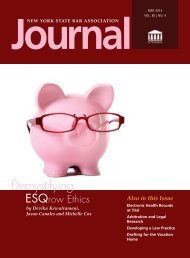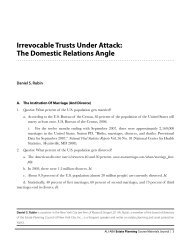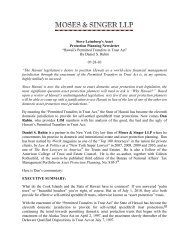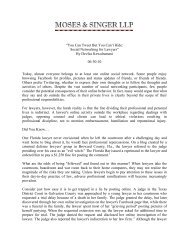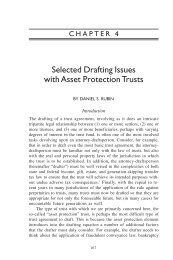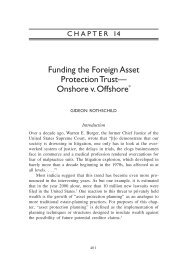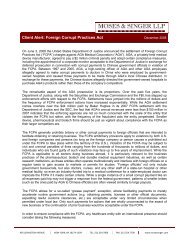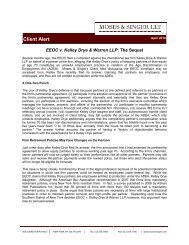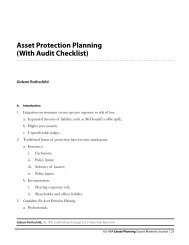Creditor Protection for Life Insurance and Annuities
Creditor Protection for Life Insurance and Annuities
Creditor Protection for Life Insurance and Annuities
You also want an ePaper? Increase the reach of your titles
YUMPU automatically turns print PDFs into web optimized ePapers that Google loves.
eneficiary of the policy (rather than as the owner of the policy) <strong>and</strong> exempts the debtor’s<br />
entitlement to the proceeds of a life insurance contract, without any specific dollar limitation, to<br />
the extent that such proceeds are “reasonably necessary” <strong>for</strong> the support of the debtor <strong>and</strong> any<br />
dependent of the debtor. For the exemption to apply the debtor has to have been a dependent of<br />
the insured at the time of the insured’s death.<br />
Since the federal exemption scheme <strong>for</strong> life insurance that is owned by the debtor is so<br />
parsimonious, if an exemption under an alternative state scheme is provided, it should be<br />
carefully considered. Following the model of the federal exemption scheme, some states provide<br />
very limited exemptions <strong>for</strong> the cash surrender value of life insurance. For example, South<br />
Carolina offers only a $4,000 exemption <strong>for</strong> the cash surrender value of life insurance (again,<br />
provided that the insured is either the debtor or an individual on whom the debtor is dependent). 9<br />
Proceeds payable to the insured’s spouse, children, or dependents are, however, generally fully<br />
exempt from the creditors of the insured. 10 Wisconsin also exempts only $4,000 (provided that<br />
the insured is either the debtor, a dependent of the debtor, or an individual on whom the debtor is<br />
dependent). 11 If the debtor is the beneficiary of the life insurance policy, however, <strong>and</strong> provided<br />
that the debtor was dependent on the insured, Wisconsin law exempts payments to the extent<br />
reasonably necessary <strong>for</strong> the support of the debtor <strong>and</strong> the debtor’s dependents. 12<br />
Other states, however, have exemption schemes that provide <strong>for</strong> far greater protection of the cash<br />
surrender value of life insurance policies than does the federal exemption scheme. For example,<br />
in keeping with its generally pro-debtor stance, Florida specifically exempts the entire cash<br />
surrender value of life insurance policies from the reach of creditors 13 <strong>and</strong> the entire death<br />
benefit from the creditors of the insured. 14 Hawaii similarly specifically exempts the entire death<br />
benefit <strong>and</strong> cash surrender value of life insurance policies from the reach of creditors of the<br />
owner of the life insurance policy, provided, however, that the policy is payable to a spouse of<br />
the insured, or to a child, parent, or other person dependent on the insured, except as to<br />
premiums paid in fraud of creditors. 15 Louisiana also specifically exempts the entire proceeds<br />
(including the full cash surrender value) of life insurance policies from the reach of creditors.<br />
The exemption is, however; limited to $35,000 of the cash surrender value if the life insurance<br />
policy was issued within nine months of a bankruptcy filing. 16 Exhibit 1 contains a state-by-state<br />
tabulation of the exemptions.<br />
New York’s scheme <strong>for</strong> the exemption of life insurance 17 is worth noting because it clearly<br />
distinguishes between the several permutations which can result depending on whether the<br />
debtor is the owner of the policy (referred to under the New York statute as the person “effecting<br />
the policy,” <strong>and</strong> need not be the person who actually purchased the policy), the insured, the<br />
beneficiary, or some combination thereof. More specifically, the New York State exemption<br />
scheme <strong>for</strong> life insurance provides that: 18<br />
1. If the owner of a life insurance policy insures his or her own life <strong>for</strong> the benefit of<br />
another (i.e., a beneficiary other than the owner’s estate), that other person shall be entitled to the<br />
proceeds <strong>and</strong> avails of the policy as against the creditors of the owner. (In other words, the<br />
beneficiary’s interest in a life insurance policy owned by another is protected from claims of the<br />
policy owner’s creditors, notwithst<strong>and</strong>ing the fact that a power to change the beneficiaries of the<br />
life insurance policy has been reserved.)<br />
3



